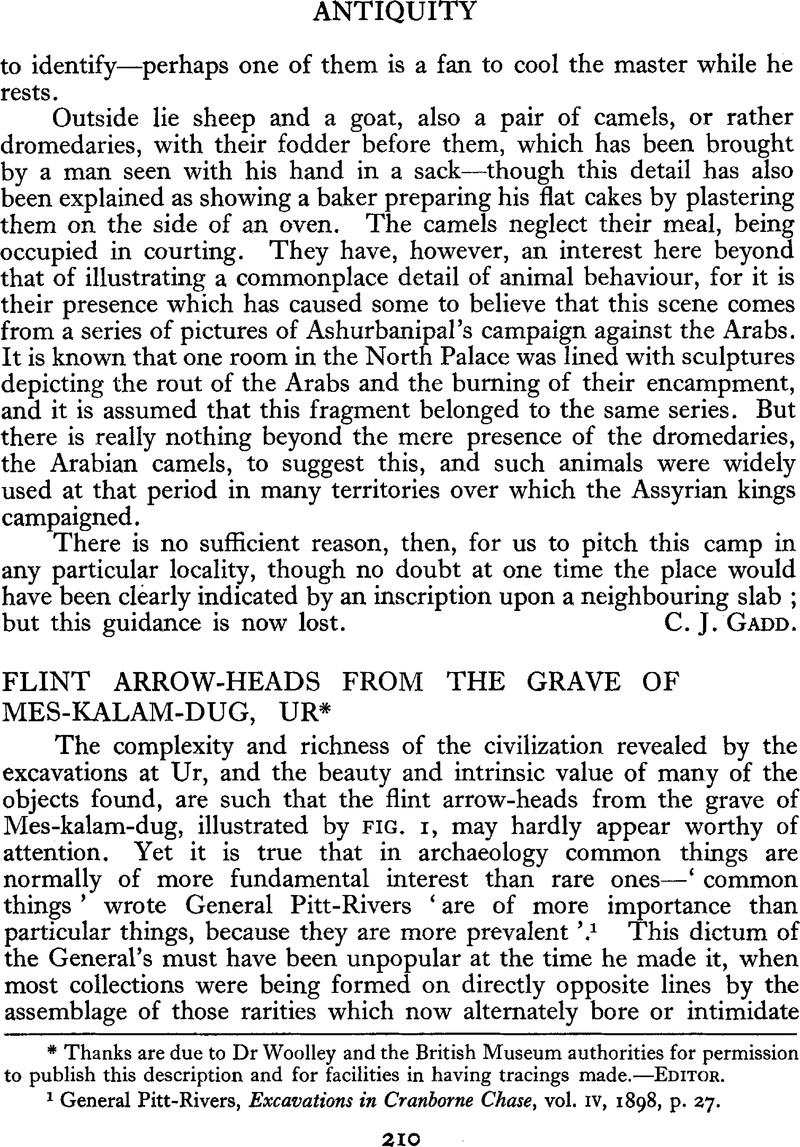Article contents
Flint Arrow-Heads from the Grave of Mes-Kalam-Dug, Ur*
Published online by Cambridge University Press: 30 June 2015
Abstract

- Type
- Notes and News
- Information
- Copyright
- Copyright © Antiquity Publications Ltd 1935
References
1 General Pitt-Rivers, Excavations in Cranborne Chase, vol.4, 1898, p. 27.Google Scholar
2 Woolley, C.L. Ur Excavations, vol. II, The Royal Cemetery, p.160.Google Scholar
3 SirEvans, John Ancient Stone Implements of Great Britain, 2nd ed., p. 369.Google Scholar
4 Müller, Sophus, ‘ Archaeologisk Udbytte af Mosearbeidet i Krigsaaret 1917’, Aarboger, 1917 p. 149. fig. I.Google Scholar
5 Kossinna, Gustav, Die Indogermanen, 1921 p. 29, fig. 40.Google Scholar
6 As the total length of arrow surviving is only 4½ inches, it is not possible to say whether the shaft was a simple wooden one, or whether it consisted of shaft and foreshaft.
7 Evans, op. cit., p. 409, fig. 344.Google Scholar
8 Another Danish specimen is in the British Museum. See Stone Age Guide, 3rd ed., fig. 181. Material of binding not indicated.
9 de Morgan, J. Prehistoric Man, fig. 41, no. 6 and p. 97.Google Scholar
10 See Evans, p. 369.
11 Clark, J.G.D. ‘Derivative forms of the petit tranchet in Britain’. Arch. Jown., 1934, 91, p. 38,Google Scholar and fig. 3, nos. I and 2.
12 Ibid. fig. 3, nos. 3 and 3a.
13 Ibid. p. 55.
14 See Bull. Soc. d’ Anthr. de Brux., 1924, p. 220 and fig. 6.Google Scholar
15 See Breuil, H. ‘Les Subdivisions du Paléolithique supérieur et leur signification’. Congr. Int. d’ Anthr. et d’ Arch. Préh., Geneva, 1912, p. 237, fig. 47 Google Scholar
16 Menghin, O. ‘Die mesolithische Kulturentwicklung in Europa’. Deutsches Arch. Inst. Rom.-Germ. Komm. Ber. 1927, pp. 162–6.Google Scholar
17 Childe, V.G. The Most Ancient East, p. 77.Google Scholar
18 Ibid. pp. 80-1.
19 Possibly it was also used as a weapon by inferior peoples. Evans, op. cit, p. 369, quotes the case of two sets of wooden figures in Ghizeh Museum from a 6th dynasty tomb at Assiut, showing on the one hand Egyptian troops with brown complexions and armed with bronze spears and shields, and on the other shorter black-faced troops ‘ armed with bow and arrows only; each (with) a bow in his left hand, and in his right four arrows with chisel-shaped heads of flint ’.
Possibly the fact that the type is a very ancient one caused it to be used for symbolical purposes in burials. Is this why such arrows occurred only in the grave of Mes-kalam-dug, and not in the other graves examined in the Royal Cemetery at Ur ?
20 Childe, V.G. op. cit. p. 96.Google Scholar
21 See de Morgan,op. cit.fig. 41, nos. 4 and 5.
22 Ibid. fig. 41, no. 8.
23 Woolley, C.L. op. cit. pp. 380–1.Google Scholar
24 Ibid.
25 Out of considerably more than 1000 microliths from the Svaerdborg site, complete enough for certain classification, the only trapeze or petit tranchet arrow-head is that illustrated. It is important to note that this was one of the few pieces not found in systematic excavation, and its association is therefore suspect. This type is entirely absent from other sites of the culture period, e.g. Mullerup, Holmegaard, Duvensee, Broxbourne, Thatcham. It is therefore unlikely to ante-date the Boreal-Atlantic transition.
26 e.g. Obermaier, Fossil Man in Spain, p. 326.Google Scholar
- 1
- Cited by




